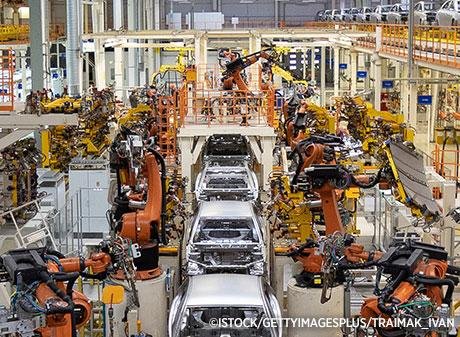Overview
The United States automotive industry is one of the largest and most influential markets globally, contributing over 3% to the country’s GDP and employing millions across manufacturing, sales, and support sectors. As of 2025, the industry is undergoing a transformational shift, driven by electrification, automation, sustainability, and changing consumer behavior.
Following pandemic-related supply chain disruptions, the market has rebounded strongly, buoyed by technological innovation, increasing demand for electric vehicles (EVs), and a consumer pivot toward connected, autonomous, shared, and electric (CASE) mobility. Federal incentives and state-level zero-emission mandates are further accelerating this transformation.
Segmentation
Key Categories
- Vehicle Type
- Passenger Cars: Sedans, SUVs, Coupes
- Commercial Vehicles: Light trucks, pickups, vans
- Electric Vehicles (EVs): BEVs, PHEVs, FCEVs
- Autonomous Vehicles (AVs): In R&D and pilot stages
- Luxury & Performance Vehicles
- Fuel Type
- Gasoline
- Diesel
- Electric
- Hybrid
- Hydrogen Fuel Cell
- Services
- Vehicle Financing & Leasing
- Aftermarket Services
- Fleet Management
- Software & Connectivity Solutions
Target Demographics
- Younger Millennials & Gen Z: Interested in EVs and mobility subscriptions
- Middle-income Families: Prefer SUVs and hybrid models for practicality
- Commercial Buyers: Businesses in delivery/logistics seeking fleet electrification
- Luxury Buyers: Opting for high-end EVs and performance vehicles (e.g., Tesla, Lucid, Cadillac EVs)
Geographic Regions
Although focused on the U.S., the market interacts globally. Regionally:
- North America: Core focus with major manufacturing hubs
- Europe: Import/export of high-end and electric vehicles
- Asia-Pacific: Significant in parts and battery supply chains
Key Players
- General Motors (GM)
- Transitioning to an all-electric future by 2035.
- Investments in battery tech via Ultium platform.
- Strong EV lineup with Chevrolet Bolt, Silverado EV, and Cadillac Lyriq.
- Ford Motor Company
- F-150 Lightning and Mustang Mach-E highlight its EV strategy.
- Heavy investment in BlueOval battery plants and software development.
- Pioneering work in connected vehicle ecosystems.
- Tesla Inc.
- Market leader in EVs with strong U.S. sales and advanced self-driving R&D.
- Vertical integration strategy offers pricing and tech control.
- Expanding Gigafactories across the U.S.
- Stellantis (Jeep, Chrysler, Ram)
- Focus on electrifying popular models and launching affordable EVs.
- Emphasizes digital transformation and in-vehicle software features.
- Toyota North America
- Leading in hybrid technology; accelerating battery-electric vehicle (BEV) push.
- Strategic hybrid and plug-in hybrid offerings for mass adoption.
- Rivian & Lucid Motors
- American EV startups offering high-end electric trucks and sedans.
- Competitive in innovation but facing production scale challenges.
Regional Analysis
Midwest (Detroit, Ohio, Illinois)
- Automotive manufacturing hub.
- Ongoing plant retooling for EVs and battery assembly.
- Government grants and retraining programs bolstering EV transition.
West Coast (California, Washington)
- Epicenter for EV innovation, software development, and autonomous vehicle testing.
- California Air Resources Board (CARB) leads in zero-emission regulations.
- High EV adoption rates.
South (Texas, Georgia, Tennessee)
- Attracting new automotive and EV investments due to business-friendly policies and tax incentives.
- Tesla's Gigafactory in Austin and Rivian’s upcoming plant in Georgia highlight the region’s growing prominence.
Northeast
- Strong demand for luxury and sustainable vehicles.
- Urban areas exploring mobility-as-a-service (MaaS) and shared EV fleets.
Latest Developments (2025)
- EV Adoption: EVs expected to account for 30-35% of new vehicle sales by 2025.
- Federal Support: The U.S. government continues offering tax credits for EVs under the Inflation Reduction Act (IRA), encouraging domestic production.
- Battery Supply Chains: Increased investment in domestic battery gigafactories and lithium processing plants to reduce reliance on Asia.
- Software-Defined Vehicles: Automakers shifting to subscription-based features and OTA updates.
- Self-Driving Advancements: Expansion of Level 2 and Level 3 autonomy in premium segments, with pilot autonomous taxi services in select cities.
- Sustainability Initiatives: Focus on circular economy, recyclability, and carbon-neutral production.
Conclusion
The US Automotive Industry is entering a golden era of reinvention. A convergence of clean energy goals, disruptive innovation, and changing consumer expectations is reshaping the entire mobility landscape. As the U.S. strengthens its position in EVs, software, and automation, the market is poised not only for economic growth but also for global leadership in sustainable and smart mobility solutions.
In the broader industry landscape, the U.S. market serves as a blueprint for next-generation transportation, offering opportunities across manufacturing, technology, infrastructure, and consumer services. Stakeholders who embrace flexibility, innovation, and sustainability will be at the forefront of this transformative journey.
